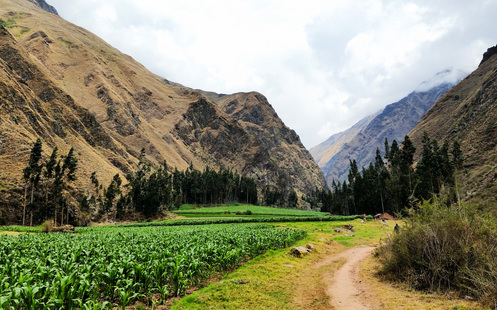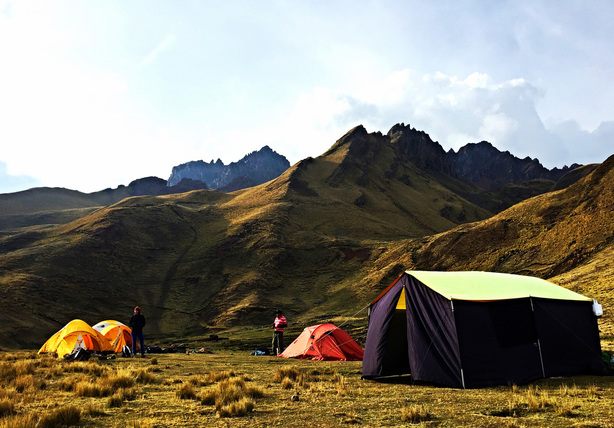The sustainable path to Machu Picchu
How Apus Peru is paving the way for responsible tourism in the Peruvian Andes
|
Deep breaths. Slow, deep breaths. This is the mantra at 15,000 feet in the Peruvian Andes, where just about everything is bigger, except for the amount of oxygen in the air. After a night spent camping in a shallow valley under jagged, glaciated peaks, we’ve just summited the highest pass of our 3-day trek. Eight more miles before reaching camp for the day, but elation, or possibly the altitude, has taken over.
|
It’s the culmination of two challenging days of hiking that makes the next 5 hours seem easy. In the short time since leaving our hotel in Cusco, we’ve witnessed Incan ruins, Quechua villages still without electricity, massive herds of sheep straddling the mountainside and leaping over streams in unison, and incredible vistas at every turn. We’ve seen a few villagers, but that’s it. No tourists, hikers, or backpackers. Nada.
Apus Peru Adventure Specialists
|
We’re making our trek to Machu Picchu with Apus Peru Adventure Specialists, a small outfit in Cusco founded by Ariana Svenson & Felicitas Callanaupa Gonzales in 2005 with the goal to "provide benefits of tourism beyond the wealthy Cusco – Sacred Valley corridor." One of dozens, if not hundreds, of trekking companies in the area, Apus is unique in its strong commitment to sustainable and ethical travel.
|
Apus Peru takes a multi-pronged approach toward sustainability, through the development work of its sister NGO, Threads of Peru, and a determined approach to environmentally friendly and responsible treks. The first agency in Cusco to seek Rainforest Alliance Verification, Apus emphasizes its socially responsible code of conduct with all travelers, offers employee training and growth programs, and has a variety projects to support Andean communities.
|
|
One such project is the Handy in the Andes Community Cleanup Trek. Hiking along either the Choquequirao or Lares route, trekkers receive the same high-quality experience of any Apus trek, but spend a few days picking up trash along the trail (which is especially important in remote areas that lack any true garbage disposal programs) in exchange for a heavily discounted rate. Apus also places a strong emphasis on their alternative treks, encouraging travelers to experience a number of different routes through this beautiful area and therefore lessen the environmental impact on the highly popular Inca and Salkantay trails. Spreading visitors across a variety of trails, they say, would make a huge impact on the long-term environmental sustainability of this region.
|
Why alternative trekking matters
|
Even with permits limited to 500 (200 trekkers, 300 tour staff) per day by the Peruvian government, the Inca Trail is vastly busier than any other route to Machu Picchu. And as with any world renowned landmark, the trail’s authenticity has been severely impacted. A route that in 1984 saw only 6,000 people, now receives hundreds of thousands of trekkers each year.
And while the reduction in permits should help curb these impacts, locals still complain about pollution, waste-disposal issues, and overcrowding. It’s a common problem for sites of such global significance, where crossing an item off the ol' bucket list often outweighs any other visitor concerns.
|
So where does Apus Peru fit into all of this? While a significant part of its business comes from the Inca Trail, Apus is focused on redirecting that traffic. The hope is that travelers will choose one of their numerous alternative routes, most of which rival the greatness of the Inca Trail, and embrace a more unique, equally incredible experience while helping to spread awareness about these less impactful routes.
Threads of Peru
|
Formed ten years ago by West Australian, Ariana Svenson and Peruvian native, Fely Callanaupa Gonzales, Apus Peru has a long held vision of sustainable tourism in Peru. This belief is part of the company’s vision and mission statements, as well as its sustainability policy, and was physically manifested by the founding of Apus’ sister NGO, Threads of Peru in 2009. “Threads,” as the team affectionately calls it, is a non-profit social enterprise working to empower indigenous artisans in the high Andes. Selling the high quality Alpaca and wool products these artisans have been weaving for thousands of years, the organization focuses primarily on the principal communities Apus treks through. And for each trek, Apus makes a $20 donation to the organization. |
Threads of Peru is a platform from which these artisans can reach a global audience. With few other economic opportunities available, Threads works closely with the artisans who weave these products, the majority of which are women, following the well documented formula that shows when you “invest in women, you invest in the family.” This not only enables them to find economic independence while living a traditional lifestyle, it also creates a gateway for weaving traditions that date back 5,000 years to reach future generations. Ultimately, the goal is to simply be a facilitator for the men and women of these communities to create their own goods and move forward independently.
Machu Picchu
The 4 am wakeup call and steep hike through dense fog ensures we’re some of the first visitors to Machu Picchu when the gates open. Passing through the entrance and into this amazing ruined city, high atop the lush jungle covered mountains, we’re overcome. The nearly 600 year old city is just as beautiful, as magical, as we ever expected. The massive carved stones that make up each building and terraced wall are just as big as we ever dreamed. And the classic view from the highest point is just as scenic as we ever hoped.
|
But quickly, as the day goes on and the sun starts to burn a little brighter and the crowds roll in, we start to daydream. Lost in the not-so-distant memory of yesterday morning. Lost in a moment atop the highest mountain we’d ever climbed, gazing upon one of the most beautiful places we’d ever seen. Most significantly, we were alone. More than anything else, Apus Peru ensured the quality of our experience in those solitary moments. They know that such experience doesn’t reside in crossing something off a list, but rather, in a connection to place. That trek took us deep into the Andes, the furthest from other travelers we may have ever been, and the closest to this place we could ever be.
|
Peru: Colonial Capitals and Inca Ruins
Traverse the Peruvian Andes. Learn how to weave and dance salsa. Drink pisco sours and coco tea. Hike to Machu Picchu.
About Apus Peru |
About Threads of Peru |
|
> Find them at https://www.apus-peru.com
> Apus offers more than a dozen alternative treks > For more information on Apus Peru’s responsible tourism practices, visit https://www.apus-peru.com/why-choose-apus-peru/how-are-we-a-responsible-travel-company > Find out more about their treks, https://www.apus-peru.com/trek |
> Find beautiful Quechua hand woven products at www.threadsofperu.com
> Look for everything from ponchos, to bags, to home decor, available through their online store and for wholesale partners > For questions, contact the Cusco team at [email protected] |


















